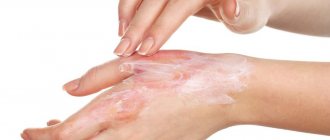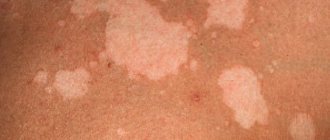Recently we received a question from our reader, after the publication of the article “SPA without a budget! Or an evening of pleasure without leaving home.” In it we talked about how taking a relaxing bath can improve your well-being and relieve emotional stress.
The question was: “I have sensitive skin and after a bath my body becomes covered with red spots. What do you advise?
Yes, this is indeed a burning topic. Due to hard and chlorinated water, many women now experience discomfort after taking a bath and do not even wash their face with tap water. But it’s one thing to experience unpleasant sensations, and another when it’s already on the body - redness.
Let's look at the main reasons.
Allergy
If the body is prone to allergies, then our skin can react to any irritant.
Common allergens:
— Various additives in centralized hot water (Chlorine, Iron, Aluminum...); — Any component included in a cosmetic product (shower gel, soap, bath foam, shampoo, etc.); — Residues of detergent on the bathroom. All cleaning products are very caustic and aggressive, and our skin often suffers from contact with them.
- Recommendations:
- If you suspect that you have an allergy, or are already 100% sure, then first of all you need to eliminate the source of irritation.
- If you don’t fully understand what the reaction is, try taking a bath and changing cosmetics every time. When a malicious bubble is discovered, read the ingredients and try to avoid similar components in the future.
- If you suspect chlorine, iron, aluminum..., conduct an experiment. Pre-boil the water and let it settle. Take a swim in this water. Then watch the reaction.
- Avoid chemicals when cleaning your bathtub. Try using baking soda to clean surfaces.
- If an allergen is identified, and for some reason you cannot eliminate it, or you have not found the source of irritation. Be sure to consult a doctor. An experienced specialist will help solve the problem.
.
Caring for dry skin after a shower or after contact with chlorinated water
Since the quality of tap water in city apartments leaves much to be desired, perhaps everyone is familiar with an allergy to chlorinated water. If you have noticed that your skin turns red and feels tight after a shower, then this article is just for you.
Skin irritation from chlorinated water can be avoided if you follow fairly simple rules.
Rule 1
Monitor the water temperature. The feeling of dryness is very familiar to those who like to visit a hot sauna. Too hot water in the shower can also cause a short-term sauna effect and make any skin type dry. It's all about thermoregulation of the body: excess heat and moisture are removed through the pores and from the surface of the skin. If after such water procedures stains appear after a shower, then you only need to blame it on inattention to your own health. In such cases, it is better to avoid lying in a hot bath for a long time.
Rule 2
During water procedures, do not rub the skin too hard with a sponge or washcloth, as this can damage the thin epidermis. Often the skin peels not after water, but as a result of such home scrubbing. For the same reason, you should not be overzealous with a hard towel.
Rule 3
Proper skin care after a shower.
Firstly, dry and itchy skin after water often appears if the interval after you turned off the water and started applying moisturizer to your body was too long.
Secondly, think about whether the cream that you are used to applying after a shower is suitable for you. It is a mistake to believe that if the cream is oily, then with its help you can solve the problem of dry skin after water. Fat creams with a thick texture can easily clog open pores, and this will not lead to anything good.
For example, you can use Panthenol EVO universal cream after a shower.
The secret of its effectiveness is simple: it contains an optimal concentration of 5% dexpanthenol, whose effectiveness has been clinically proven. The cream noticeably restores the skin after daily contact with chlorinated water, helps you forget about stains after a shower and forget about itching after water.
Panthenol EVO body milk with 2% Dexpanthenol and vitamin E is also perfect. It has a light texture, and therefore is instantly absorbed, without leaving an oily sheen on clean, washed skin.
After application to the skin, panthenol easily transforms into pantothenic acid and takes a direct part in fat and carbohydrate metabolism, normalizing cellular metabolism, and restoring damaged skin. To strengthen the effect of panthenol, EVO Body Milk is additionally enriched with vitamin “E”, which has the flattering name of the “beauty” vitamin.
If after water not only the skin of the body itches, but also the skin of the hands looks like “chicken feet”, then it is recommended to use a product containing at least 5% dexpanthenol in the cream, for example, the same universal cream Panthenol EVO. It will not only help your hands, but is also suitable for daily and special care of very dry and sensitive body skin.
It remains only to add that these products can be used without fear of an allergic reaction of the body. Panthenol EVO cream and Panthenol EVO body milk have been tested many times, and their hypoallergenicity and effectiveness have been clinically proven.
Close location of capillaries to the surface of the skin
Another reason for redness. From irritation and hot water, the vessels dilate and become more visible than usual.
- Recommendations:
- We exclude: rubbing the skin with a hard washcloth, cosmetic scrubs and peels, sudden changes in water.
- If you are a fan of high temperatures, then redness will appear again and again. Take a bath with moderate or even slightly cool water temperature. Reduce the temperature gradually; you can use a special thermometer to control the process. For example, reduce by 1 degree every month. Important!
Lying in cool water for a long time is, of course, not recommended, here you focus on comfort, usually it is about 37-40 degrees. But for the shower you can use less. But remember that a cold shower is already hardening, and a special approach is needed here.
Nervous system disorders
Stress, nervousness, an unfavorable emotional environment at home or at work - all this can be reflected in red spots on the body. In this case, the bath serves as a kind of accelerator that brings out all your experiences.
- Recommendations:
- Analyze the situation, perhaps you will find a certain pattern.
- You can drink herbal soothing infusions yourself. Spend more time outdoors and relax.
- If you feel that you cannot cope on your own, consult a doctor. Sometimes stress is of a deeper nature, then it is advisable to undergo a course of drug therapy.
Sensitive skin.
Sensitivity can be with you almost all your life, or it can appear suddenly.
Symptoms of sensitive skin:
— Excessively whitish tint of the skin; - Tightening sensation after taking a bath; - Irritations that sometimes arise “out of the blue”; — Tendency to form pigment spots; - You periodically experience: burning, swelling, tingling, redness, itching, peeling; — Susceptibility to ultraviolet rays (leading to burns).
- Recommendations. What it is not advisable to do if you are hypersensitive:
- Take an excessively hot bath;
- Rub the skin with a hard washcloth;
- Use scrub or peeling frequently;
- Clean the bathtub with aggressive chemicals
- From various bath foams, gels, soaps - having a hard or “questionable” composition;
- Add salt and/or potent essential oils to the bath.
What is better to avoid:
Beauty tip:
— Buy eco-friendly or natural body cosmetics, without chemical components; — Or try making homemade cosmetics yourself; — Take a bath with herbal infusions. Choose those that will relieve irritation and soothe sensitive skin - Install a main filter for water purification (today this is an excellent solution for any skin type)!
Color of the skin
Look to see if any changes have appeared on your face, such as swelling or hyperpigmentation. Skin color is very important in assessing health.
Straw color.
If you have a straw complexion, you need to do a biochemical blood test. The symptom often signals a vitamin B12 deficiency.
B12 deficiency is obvious if a set of symptoms is present:
- lips have a straw tint;
- epigastric pain occurs;
- there is a burning sensation of the tongue;
- depression is present.
B12 deficiency can be expressed not only by a discolored complexion, but also by other symptoms.
Gray complexion.
A grayish tint to the face appears in people with chronic lung disease and in smokers. However, in the latter, chronic lung pathology occurs most often.
Smokers should regularly undergo spirometry testing to diagnose the disease. And if your skin color has taken on a gray tint, you need to get checked immediately.
Paleness of the skin.
Pale facial skin indicates anemia or low blood pressure. The condition is especially noticeable with temporary drops in pressure.
Redness.
If the face turns red, this may indicate pressure surges. When it comes to experiencing strong emotions, the problem is temporary and does not pose a danger.
With constant redness of the face with simultaneous redness of the conjunctiva, a comprehensive diagnosis is required, including a set of specialized cardiological studies. Such symptoms are caused by vascular diseases and heart problems.
But redness in the form of symmetrical spots on the nose and cheeks, resembling the shape of a butterfly, is one of the initial manifestations of lupus, one of the most dangerous and formidable kidney diseases.
Hyperpigmentation spots
. If the spots are brown and appear randomly, mainly on the forehead and cheeks, these are rather symptoms of impaired liver function. A blood test should be done for so-called liver tests.
In this case, it is recommended to exclude from the diet:
- coffee and alcohol;
- fats;
- spicy spices;
- foods with saturated and trans fats.
If the spots are symmetrical and appear on the upper lip, then the condition often indicates hormonal disorders.
Diseases of internal organs
If all of the above reasons do not apply, we can assume some kind of internal organ disease. Our body is an integral and complex system; when one organ is disrupted, there is often a reaction to another. And since the skin is our largest organ, we can observe a side effect - from the outside.
- Recommendations: There is only one recommendation here - consult a doctor. Perhaps by external manifestations our body, as it were, “draws attention” to a more important problem.
In this article, we briefly examined the main reasons why red spots may appear on the body after taking a bath. If you, like our reader, want to eliminate this unpleasant symptom, write in the comments:
- Was this article useful to you?
- Why do you think red spots may appear?
- What information did you miss, and maybe the next article will reveal it in more detail?
Thank you for your attention!
Author of the article: Lina Zdorovie Official website of the author: LinaBlog.ru Instagram:@linazdorovie
Why does the skin on the body become covered with spots?
If red spots appear on the skin after a normal daily shower, this may be the result of completely natural factors:
- Various intensity of soaping with a washcloth (pronounced friction).
- The use of rather aggressive detergents that irritate the skin.
- Irritation from too hot or cold water.
- Applications of a contrast shower.
- Using scrubs and other exfoliating products or products with peeling properties.
- Application of different compositions for depilation of arms, legs and bikini area.
Natural spots on the skin go away quite quickly and do not cause discomfort. Such marks are completely harmless to health.
The face becomes red
Natural redness of the face after a shower or bath is the result of the activity of the autonomic nervous system. If there is an imbalance in its work, the skin on the face may become covered with uneven spots. This symptom is also not dangerous and does not cause any discomfort. However, it is a reason to listen more closely to the work of your body. After all, insufficiently stable functioning of the autonomic nervous system can also manifest itself:
- Unmotivated anxiety, insomnia, nervousness.
- Frequent heartbeat.
- Pressure changes.
- Nausea, dizziness, faintness.
- Panic attacks.
- Extreme heat, sweating, feeling of lack of air, etc.
In fact, an imbalance in the functioning of the autonomic nervous system in itself is not dangerous. However, progressive problems are fraught with a strong deterioration in well-being and emotional state.
Skin turns red due to taking a bath
If redness on the body appears exclusively after taking a bath, its formation may be associated with the duration of the water procedure or the scale of the influence of water. Red spots may occur due to:
- The factors already listed, in particular, exposure to washcloths, scrubs, and too hot water.
- The characteristics of the water itself, in particular, the presence of chlorine and other impurities in it (this type of redness is not an allergy, but rather has the appearance of irritation).
- The presence of skin diseases that are activated and manifest massively after prolonged exposure to water. Eczema, psoriasis and some dermatitis can behave this way.










